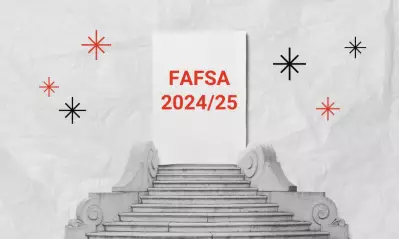How to transfer college credits in seven steps
This article was updated on February 27, 2024.

Written by Elizabeth Exline

Reviewed by Bronson Ledbetter, MBA, Vice President, Student Services and Financial Operations

Earning a bachelor’s degree doesn’t always happen in a linear fashion. And that’s OK. Like a recipe you improve with substitutions and additions, completing an undergraduate degree can become an enriching and achievable goal with the help of college credit transfers. But how do you transfer college credits? Here is a seven-step process.
Before you start the process to transfer college credits
Between 30% and 39% of undergraduate students transfer college credits at some point during their college career. Before beginning the process, it's good to understand how college credits work.
Each college course a student passes is usually worth a certain number of credits, ranging from one to five credits per course. This is based on a semester system. Some institutions use quarter and trimester systems, which affect the way credits are issued. For course credits to count toward your degree, you need to earn a passing grade, as determined by the university’s academic policies.
In most cases, the number of credits attached to a course reflects the number of hours per week the school expects you to spend in class and studying. For example, a three-credit course typically requires three hours in class and six hours of study per week.
The credit hour is a fundamental unit of measurement used in higher education to quantify the instructional time and academic effort required to complete a course. In the United States, it serves as a standard for awarding academic credit toward degrees or certificates. Typically, one credit hour represents one hour of classroom or direct faculty instruction per week over a semester, trimester or quarter. Additionally, students are expected to spend an average of two to three hours of study and preparation outside of class for each credit hour.
In essence, the credit hour provides a way to equate different learning experiences and ensure consistency in academic workload across courses and institutions, facilitating the transfer of credits between programs and institutions. Generally, a three-credit course taken over a traditional 15-week semester would require 45 hours for faculty-led instruction and 90 hours of student-driven preparation and homework.
Most colleges require you to accumulate a set number of credits to graduate. For example, a bachelor’s degree usually requires around 120 earned credits. Associate degrees often require about 60 credits.
How many students transfer college credits?

About 1 in 3 students who start at a two-year public college transfer to a four-year college.*

Nationally, nearly two-thirds of community college students who transfer to a four-year institution earn a bachelor’s degree within six years.*

Transfer students are common. Approximately 1.2 million undergraduate students in 2023 were able to transfer college credits to their new college.*
Steps to transfer college credits
There’s a process to follow once you decide to transfer college credits you've earned to another school. Getting the proper details in order at both schools ensures the process goes smoothly and doesn’t affect your anticipated graduation date.
1. Get familiar with your school’s transfer policies. All schools publish their policies regarding how many and which transfer credits they’ll accept, with the standard ranging between 15 and 90 credits. Picking a “transfer-friendly” school can help you save time and money.
2. Request your unofficial transcript(s). Contact the registrar at every school you’ve attended to request your unofficial transcripts. Having a record of which courses you’ve successfully completed will help you identify which college credit you can potentially transfer to your new school. Unofficial transcripts may be available on your institution’s student portal as well.
3. Know that all credits are not created equal. Some colleges operate on a quarter system, others on a semester system -- and they are not always equivalent. This discrepancy doesn't account for other potential credit, either. Don't expect an easy one-to-one transfer for all your college credits.
Even though college credits don’t technically expire, in some situations, they may not be eligible. Schools may not allow transfer credits from institutions without valid accreditation. In addition, course content that isn’t relevant to a new program or that is no longer accurate or up to date may not apply. And every institution has its own policies with regard to grades. You may need to have earned a certain grade in a course in order for the credit to transfer.
4. Look for transfer opportunities in general education requirements. Whether you're transferring from a community college or going back to school at 30 to finally finish your bachelor's degree, having your transcripts in hand can help narrow down which courses you need to take. this is especially important if you're in a hurry to study core subjects.
General education requirements are the most common area where transfer credits apply, although some credits may occasionally transfer to core programs or majors.
5. Check with your new school. Make an appointment to speak with an enrollment or admissions representative at your new school to ensure you get the credit you qualify for.
6. Make it official. Your new school will need official transcripts from all institutions you’ve attended in order to review and award college transfer credit. Be aware that a minimal fee may be associated with these transcript requests. If everything looks correct, apply as a transfer student.
7. Be realistic. It is possible that not all of your credits will transfer. In fact, students lose an average of 13 credits when transferring schools. This can be frustrating, but it’s more incentive to find a transfer-friendly school where you can get the most credit for the work you’ve done.
Are you ready to take the first step to transfer college credits?
University of Phoenix believes in helping remove barriers to education, and accepting transfer college credits where and when possible is part of that commitment. If you're interested in beginning the transfer process or want more information, contact an admissions representative.

The 3+1 transfer pathway allows students to earn three years of general course requirements at a participating community college and then apply those credits toward a bachelor’s degree at UOPX, which they can complete in just over a year.

The Transfer Scholarship of up to $3,000 is available to new qualifying students pursuing a bachelor’s degree.

UOPX accepts credits from more than 5,000 institutions and will request official transcripts at no charge when possible. Get a sneak peek at what might be possible using the University's TransferPath app.
Curious to learn more? Watch How to avoid credit transfer pitfalls on YouTube
* Sources: Department of Education, National Center for Education Statistics, National Student Clearinghouse Research Center

Read more articles like this:

ABOUT THE AUTHOR
Elizabeth Exline has been telling stories ever since she won a writing contest in third grade. She's covered design and architecture, travel, lifestyle content and a host of other topics for national, regional, local and brand publications. Additionally, she's worked in content development for Marriott International and manuscript development for a variety of authors.
This article has been vetted by University of Phoenix's editorial advisory committee.
Read more about our editorial process.




